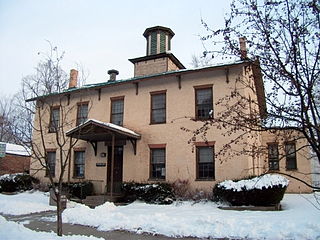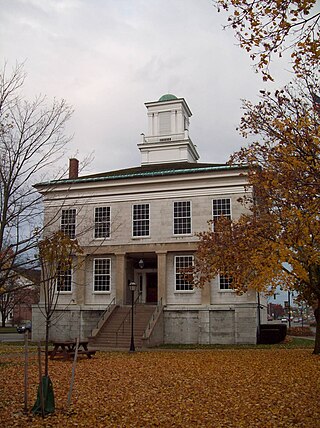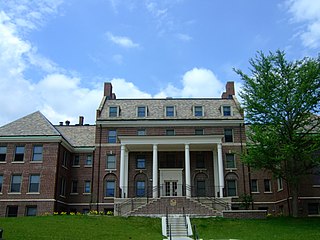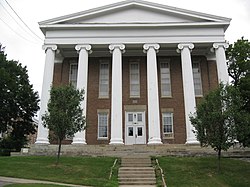
The Lansingburgh Academy was a seminary in Lansingburgh, New York. The seminary was in existence from the late 18th century to 1900, when the building that housed it was leased to the Lansingburgh School District. The building was sold to the school district in 1911. Initially used as a high school, the Lansingburgh Academy was eventually sold to the local library system; as of 2007, it served as the Lansingburgh Branch of the Troy Public Library. The Lansingburgh Academy was listed on the National Register of Historic Places in 1976.
Lima is a town in Livingston County, New York, United States. The population was 4,305 at the 2010 census. The town is in the northeast part of the county, south of Rochester. The village of Lima is located within the town.
Jesse Crowell was a pioneer settler in Michigan, who platted Albion, Michigan, in 1836, was its first postmaster, and played an important role in the public affairs and the development of Albion. He is renowned as Albion's Greatest Benefactor.

Kents Hill School is a co-educational, independent college-preparatory school for boarding and day students. Kents Hill is located in Kents Hill, Maine, 12 miles west of the state capital of Augusta. It is the 30th oldest boarding school in the United States and one of the oldest continuously operating co-educational college preparatory schools. One of the three oldest Methodist academies in the United States, the school is now a member of the Association of Independent Schools in New England (AISNE) and accredited by the New England Association of Schools and Colleges (NEASC).

Sanborn Seminary is a historic educational facility in Kingston, New Hampshire. Its main building was built in 1883 by Major Edward S. Sanborn to serve as a secular secondary boarding school. The school ran continuously until 1966 when it was sold to the Town of Kingston. The campus became known as Sanborn Regional High School and served students from the towns of Kingston, Newton, and Fremont. The last class at this campus graduated in June 2006.

Old Queens is the oldest extant building at Rutgers University and is the symbolic heart of the university's campus in New Brunswick in Middlesex County, New Jersey in the United States. Rutgers, the eighth-oldest college in the United States, was founded in 1766 during the American colonial period as Queen's College. Queen's College was named for Charlotte of Mecklenburg-Strelitz, the daughter of a German duke who became the queen consort of British king George III. Old Queens is located on a six-acre hilltop city block bounded by Somerset Street, Hamilton Street, College Avenue and George Street that was previously an apple orchard. Donated to the college in 1807 by James Parker, Jr., this city block become known the Queen's Campus and is the historic core of the university. Because of this, by metonymy, the name "Old Queens" came to be used as a reference to Rutgers College and is often invoked as an allusive reference to the university or to its administration.

The Samuel Russell House is a neoclassical house at 350 High Street in Middletown, Connecticut, built in 1828 to a design by architect Ithiel Town. Many architectural historians consider it to be one of the finest Greek Revival mansions in the northeastern United States. Town's client was Samuel Russell (1789-1862), the founder of Russell & Company, the largest and most important American firm to do business in the China trade in the 19th century, and whose fortunes were primarily based on smuggling illegal and addictive opium into China.
The Genesee Wesleyan Seminary was the name of two institutions located on the same site in Lima, New York.

Elim Bible Institute and College is a private Christian college in Lima, New York. It awards bachelor's degrees, associate degree, and one-year certificates.
This is an incomplete list of historic properties and districts at United States colleges and universities that are listed on the National Register of Historic Places (NRHP). This includes National Historic Landmarks (NHLs) and other National Register of Historic Places listings. It includes listings at current and former educational institutions.
Genesee College was founded as the Genesee Wesleyan Seminary, in 1831, by the Methodist Episcopal Church. The college was located in Lima, New York, and eventually relocated to Syracuse, becoming Syracuse University.

Schenectady City Hall is the seat of government of the city of Schenectady, New York, United States. Designed by McKim, Mead, and White, the building was constructed between 1931 and 1933. It is located on the block between Clinton, Franklin, Jay and Liberty streets. It is built in a revival of the Federal Style, the dominant style of American architecture from 1780 to 1830. Its most prominent features include the square clock tower, with its gold-leaf dome and weathervane, and the Ionic neoclassical portico. It houses not only city government but the local office of U.S. Rep. Paul Tonko.

The Genesee County Courthouse is located at the intersection of Main and Ellicott streets in Batavia, New York, United States. It is a three-story Greek Revival limestone structure built in the 1840s.

The Genesee County Courthouse Historic District is located at the junction of Main, West Main and Ellicott streets in downtown Batavia, New York, United States. It is a small area with the county courthouse, a war memorial and other government buildings dating from the 1840s to the 1920s. Some were originally built for private purposes.

The Stafford Village Four Corners Historic District is located at the junction of New York state routes 5 and 237 in Stafford, New York, United States. It is a collection of six buildings of various types from the 19th century, one of which is the oldest house in Genesee County.

Dansville Library is a historic library located at Dansville in Livingston County, New York. It is a large two story Neoclassical style frame structure. It is dramatically enhanced by a pedimented, giant portico covering its full width. The portico features four Doric columns, an elaborate frieze with triglyphs and rosettes, a modillion cornice, and a semi-elliptical fan decoration in the cornice. The earliest section was built in 1823 as a private home for Joshua Shepard (1780–1829). The Shepard family donated the house for use as a library in 1923.

Cayuga County Courthouse and Clerk's Office is a historic courthouse complex located at 152 Genesee Street in Auburn, New York. It consists of a two building government complex. The courthouse was built in 1835–1836 to a design by John I. Hagaman in the Greek Revival style, employing a massive Greek Doric order. It was rebuilt and expanded in 1922–1924 after a fire destroyed everything but the front and side walls of the original building. The rebuilt courthouse, designed by Carl Tallman and Samuel Hillger, is a 2+1⁄2-story, Neoclassical temple-fronted stone building incorporating Hagaman's monumental portico. Attached to it is the 1882 County Clerk's Office building, designed by Green and Wicks in the Late Victorian Italianate style.

College Hall is the central building of the campus of the Vermont College of Fine Arts in Montpelier, U.S. state of Vermont. Located prominently on Ridge Street atop Seminary Hill, this 1872 Second Empire building has been a major visual and architectural landmark in the city since its construction. It was listed on the National Register of Historic Places for its architectural significance in 1975.

Alexander-Dickman Hall, formerly known as Old Sem, Old Main, and College Hall, is a historic building located on the campus of Upper Iowa University in Fayette, Iowa, United States. It was the first building built for the college, and for a number of years it was its only building. Construction on the building began in 1855 and it was completed two years later. Its significance derives, in part, from it being "one of the largest and best preserved native stone buildings still in use in Iowa." Architecturally, the three-story limestone structure is influenced by several styles. Its simplicity of form reflects the Neoclassical style in its evenly spaced windows and arched doorway. The Palladian windows and the structure's tripartite arrangement capped by a triangular pediment of the main facade reflects the Federalist style. The bracketed eaves at the cornice reflects the Italianate style. The building is capped with a domed cupola. It received its present name in 1963 being named for the man who first financed to college (Alexander) and its president in the 1920s (Dickman). The building was listed on the National Register of Historic Places in 1976.

The Methodist Deaconess Institute—Esther Hall, also known as Hawthorn Hill Apartments, is a historic building located in Des Moines, Iowa, United States. This building has been known by a variety of titles. They include the Bible Training School, Women's Foreign Missionary Society; Women's Home Missionary Society-Bible Training School; Iowa National Bible Training School; Iowa National Esther Hall & Bidwell Deaconess Home; Hawthorn Hill; and Chestnut Hill. The Women's Home Missionary Society of the Methodist Episcopal Church established a Des Moines affiliate in 1896. Part of their responsibilities was to oversee the work of deaconesses of the church. At about the same time a Bible training school was established at Iowa Methodist Hospital's School of Nursing.



















